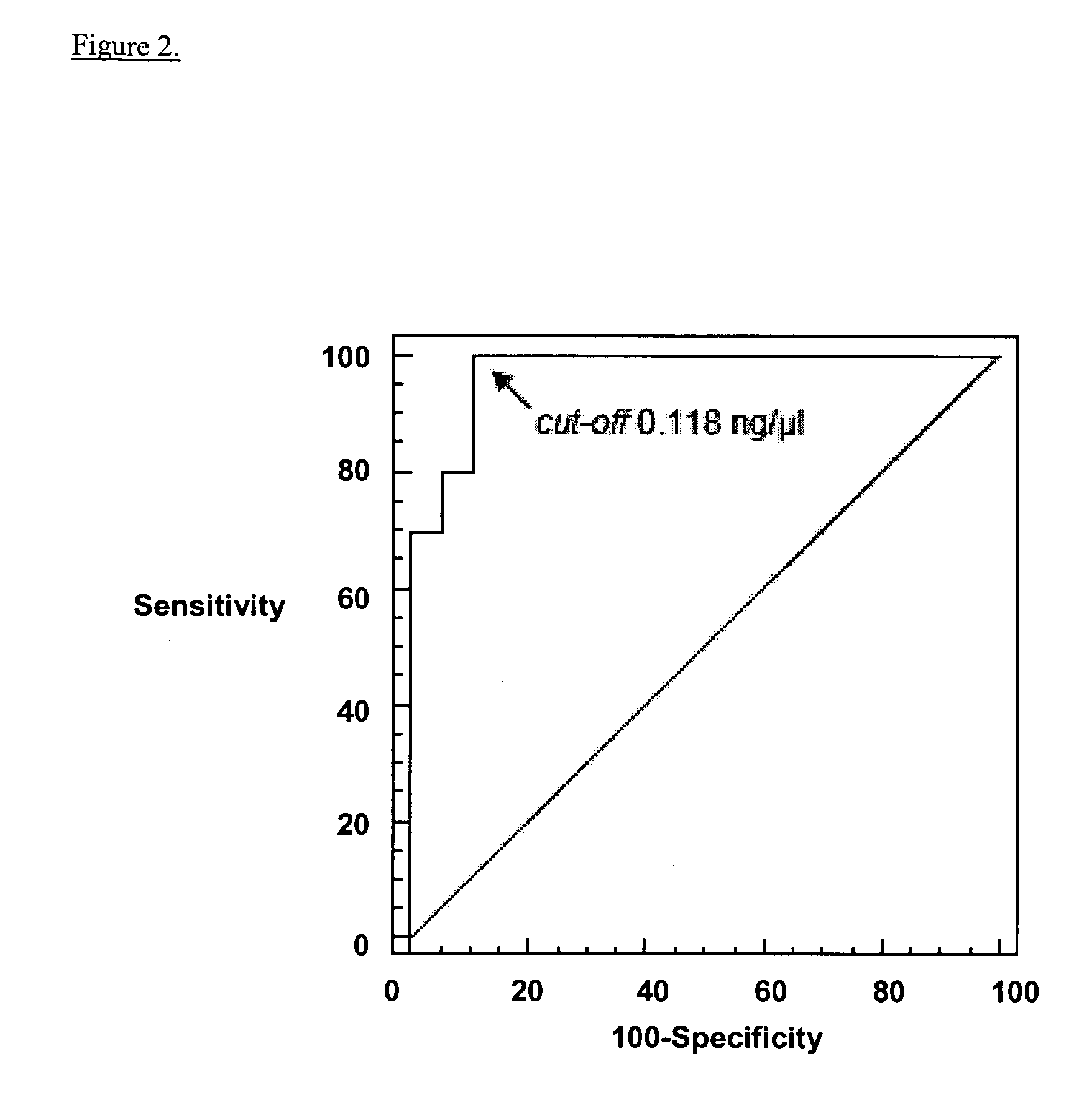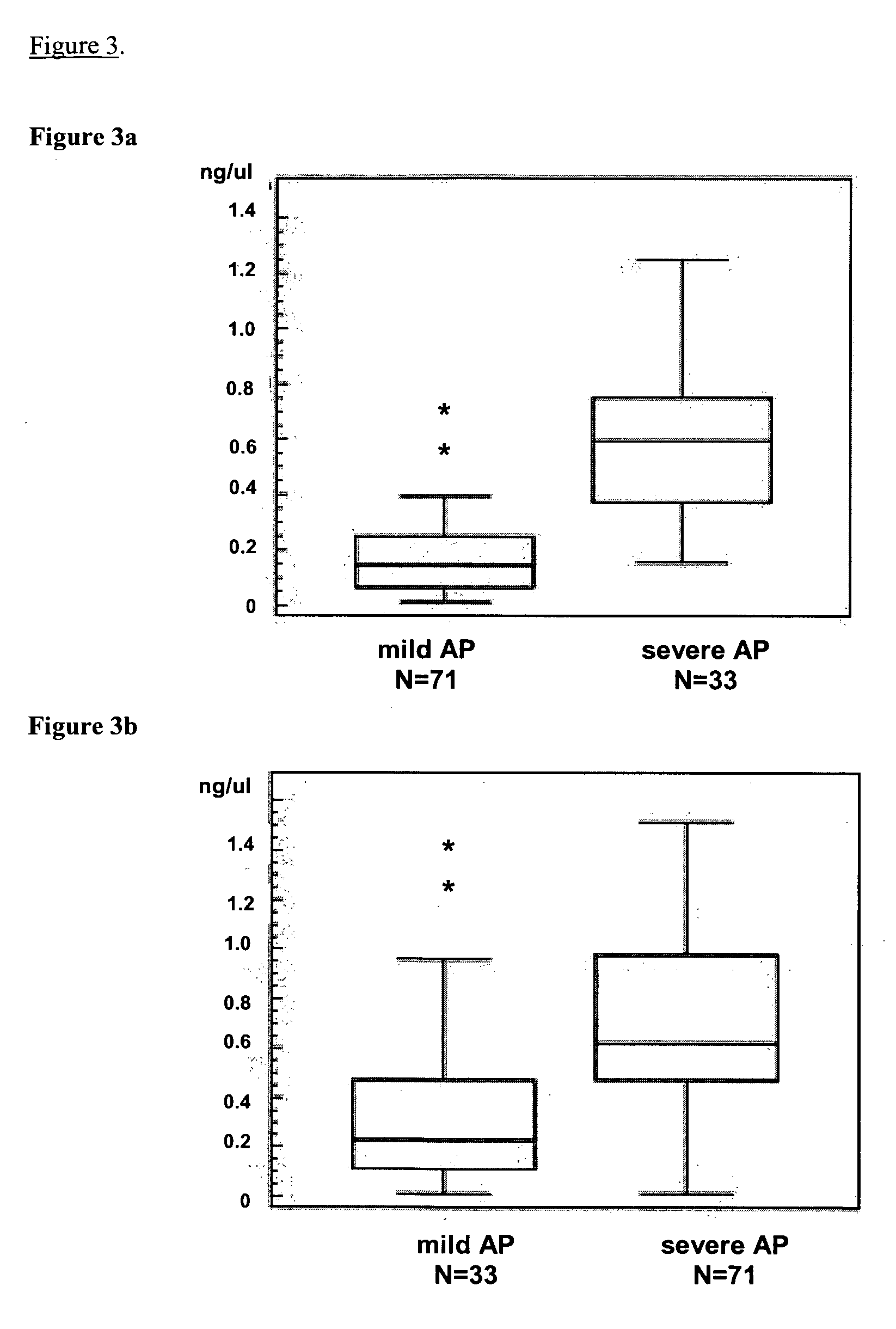Use of free DNA as an early predictor of severity in acute pancreatitis
a pancreatitis and free dna technology, applied in the field of acute pancreatitis severity prediction, can solve the problems of not being readily available, affecting the prognosis of the disease, failure of different organs, etc., and achieves low high level of cell-free dna, and high risk of ap development.
- Summary
- Abstract
- Description
- Claims
- Application Information
AI Technical Summary
Benefits of technology
Problems solved by technology
Method used
Image
Examples
example 1
[0054]Free Serum DNA Study
[0055]The inventors investigated free serum DNA obtained from AP patients to determine its correlation with the extent of pancreatic necrosis and as an early marker of severity. Free serum DNA was measured in sera from 30 patients with acute pancreatitis at admission, on the first, fourth and seventh day following admission. On the first day following admission, patients who would subsequently develop severe pancreatitis had significantly higher serum DNA levels than those with mild disease (median 0.271 ng / μl vs. 0.059 ng / μl respectively; P<0.001). This parameter showed very good characteristics as a severity predictor (area under ROC curve 0.97). Free serum DNA was also in correlation with the extent of pancreatic necrosis. Thus, free serum DNA was determined to correlate with the extent of pancreatic necrosis and is an early marker of severe acute pancreatitis.
example 2
Comparative Serum Plasma DNA Study
[0056]The inventors investigated free serum DNA and free plasma DNA obtained from patients with AP to determine the correlation of each with the extent of pancreatic necrosis and as an early marker of severity of AP. In previous studies on a small (30 AP patients, 18 controls), carefully selected population (Gomik, et al., Clinical biochemistry 2009; 42:38-43), the inventors obtained a very high “post-hoc” calculated power of the study (100% power; beta error 0% alpha error 1%). Therefore, the inventors widened the inclusion criteria, and used a smaller but still significant difference, on day 4 from the previous study, as the reference for the sample size calculations. The sample size with alpha error of 1% and beta error of 5% (power of 95%) calculates to 51, which, after correcting for unequal distribution of mild (cca 80%) and severe (cca 20%) cases of acute pancreatitis, rises to 70.
example 3
Patients and Control Group
[0057]A study on the serum DNA and a comparative study on plasma and serum DNA were conducted at the Department of Medicine, University Hospital Centre Zagreb. Adult patients (≧18 years) diagnosed with acute pancreatitis, regardless of etiology, were considered. Inclusion criteria were: clinical presentation consistent with acute pancreatitis (abdominal pain, nausea, vomiting, etc.); more than threefold elevation of serum amylase activity; and more than fivefold elevation of urine amylase activity. Patients with terminal illnesses and patients in whom pancreatitis was not a primary admission diagnosis or in whom pancreatitis was a manifestation of other acute or chronic conditions (e.g., pancreatitis in trauma or pancreatitis during chemotherapy) were excluded. Pregnant patients were also excluded. For the study on serum DNA, patients with other possible causes of elevated amylase activity (e.g., renal impairment, hyperlipidemia) were excluded. Elevation (m...
PUM
| Property | Measurement | Unit |
|---|---|---|
| volume | aaaaa | aaaaa |
| volume | aaaaa | aaaaa |
| concentrations | aaaaa | aaaaa |
Abstract
Description
Claims
Application Information
 Login to View More
Login to View More - R&D
- Intellectual Property
- Life Sciences
- Materials
- Tech Scout
- Unparalleled Data Quality
- Higher Quality Content
- 60% Fewer Hallucinations
Browse by: Latest US Patents, China's latest patents, Technical Efficacy Thesaurus, Application Domain, Technology Topic, Popular Technical Reports.
© 2025 PatSnap. All rights reserved.Legal|Privacy policy|Modern Slavery Act Transparency Statement|Sitemap|About US| Contact US: help@patsnap.com



